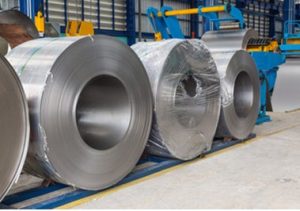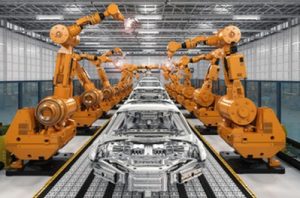
Today’s factories must produce more products faster than ever before yet maintain quality to remain competitive worldwide. Human error, system breakdowns, and incorrectly made items are reduced or virtually eliminated in advanced production and processing systems. This is made possible by adding automation and electronic systems technology to their companies.
 Automation means working with raw materials, making products, and assembling them automatically by using electronic controls. Companies purchase computers, electronic devices, and advanced equipment and network them together to improve the quality, quantity, and safety of their products.
Automation means working with raw materials, making products, and assembling them automatically by using electronic controls. Companies purchase computers, electronic devices, and advanced equipment and network them together to improve the quality, quantity, and safety of their products.
Of course, there are job shops and individual craftsmen who make terrific products with manual labor and simple machinery for personal and business use. For those organizations that depend on mass production, automation and electronic systems technology is a must.
Start with Raw Materials
Making products begins with ideas, drawings, resources, and the knowledge to proceed. The drawings’ specifications typically describe the raw materials needed to begin the basic processing.
Engineers design the technology and automated equipment to transform raw materials such as wood, metal, or water into the beginnings of a consumer or business product.
The automation team must rely on proper data analysis, quality equipment, and coordinated efforts to reach production timelines. Savvy company buyers maintain two or three different suppliers for each raw material needed so there won’t be shortages.
Companies typically buy in bulk quantities to obtain lower prices. Adequate planning is required to also store the raw materials before and during the conversion process.
Making the Parts
 Once raw materials pass through their initial conversion, the workflow must continue to produce all necessary parts for the finished products. Metal parts are typically created by cutting away metal to shape them. There are four non-cutting metal removal processes:
Once raw materials pass through their initial conversion, the workflow must continue to produce all necessary parts for the finished products. Metal parts are typically created by cutting away metal to shape them. There are four non-cutting metal removal processes:
- Chemical Milling removes metal by the etching reaction of chemicals on metal.
- Electrochemical Machining eats away metal in a controlled fashion by the action of an electric current.
- Electro Discharge Machining and Grinding cuts or erodes metal by applying high-energy sparks or electrical discharges.
- Laser Machining cuts material away with an intense beam of light from a laser.
Different materials like plastics, wood, ceramics, and rubber go through other types of forming and shaping to reach the desired part design. Next, parts are made into prototypes and readied for mass production.
“Today’s factories must produce more products faster than ever before yet maintain quality to remain competitive worldwide. This is made possible by adding automation and electronic systems technology to their companies.”
Assemble the Prototype and Begin Major Production
Once parts are perfected and the prototype is accepted, the product is ready to go into mass production. Of course, this step comes only after market research shows there is sufficient demand to justify the expense involved.
 An automation system powered by electronics is required for a mass assembly line to produce the required quota of products. Limited human interaction is needed because robotic devices and electronic equipment do most of the work. Technicians work to monitor and repair any system issues, and document and report their inspection findings to their supervisors.
An automation system powered by electronics is required for a mass assembly line to produce the required quota of products. Limited human interaction is needed because robotic devices and electronic equipment do most of the work. Technicians work to monitor and repair any system issues, and document and report their inspection findings to their supervisors.
Getting the Products to Market
Let’s back up a moment to mention the activities of the shipping and receiving departments in factories. They too are automated with electronic equipment in many of today’s factories and warehouses. Conveyor lines move parts and products in and out of these facilities to speed up the processes of entering inventory and shipping final products to customers.
Automation technicians work with this part of production and processing as well as the formal manufacturing of goods. If this career interests you, earn an associate degree so you can obtain a viable entry-level job in automation and electronic systems technology.
Learn How to Obtain a Position in This Dynamic Career
Launch your career by earning an Associate of Occupational Studies (AOS) Degree in Automation and Electronic Systems Technology. Start by requesting information about the program and college of your choice. Follow up with meeting with an Admissions Representative and strolling through the college campus.
ITI Technical College in Baton Rouge invites you to check out what we have to offer. Since 1973, thousands of students have graduated with a technical degree and found employment in the career of their choice.
For more information about graduation rates, the median debt of students who completed the program, and other important information, please visit our website at: https://iticollege.edu/disclosures/




